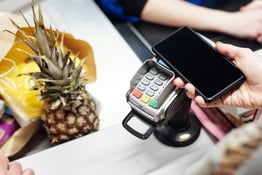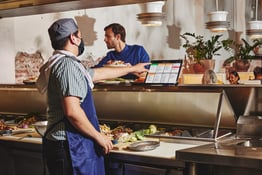Restaurant robots are growing in popularity, a trend that seems to be here to stay. By most accounts automation improves restaurants' hygiene, lowers costs, and makes workplaces safer. In the past decade we've seen the arrival of tableside and kiosk ordering, as well as robotic chefs, servers, bartenders, and baristas. The question has clearly been answered of whether robots will feed us — they're already on the job.
Now, we're left to wonder about a more existential question about how we feel about the situation of removing people from the equation of dining. It’s OK to be wary. This is a big societal shift in restaurant technology, colored by the emotional intimacy we all feel around food.
Here’s what you need to know about the future of robots and automation in the restaurant industry.
When is automation coming to the restaurant industry?
That future has already arrived and made itself comfy. Just check out 10 restaurants leading the way on robotics for a sense of what successful automation looks like. The list includes major chains like Dominos, which pioneered a robust online tracking system, as well as smaller fast casual restaurants like Spyce, where robots make your meal as you watch, stupefied and possibly shooting video on your phone.
The industry will never automate completely. Many folks working in robotics see their tech as a way to improve the lives of chefs, not to replace them. To these inventors and entrepreneurs, automation promises higher profits for corporations and for small businesses. And they remind people that the first tasks robots handle will be those most rote.
Front of house operations — POS systems, menu management, and ordering — have been getting more automated for years. Anthony Tayoun, the co-founder, COO, and CFO of Dexai Robotics, says that labor shortages and high demand for delivery have spurred quicker adoption of automation in the back of house, as well.
"The rest of the operation is only starting to get automated now, including bussing, food prep, cooking, and meal assembly," Tayoun said. "While the first few solutions are purpose-built, we believe that in the long run more versatile and adaptable automation will be necessary."
Automation in fast food ordering systems
Fast food companies are a model for successful automation. McDonald’s has rocked the kiosk ordering system for years, and is currently testing automated drive-thru ordering. KFC Korea has been working with Hyundai Robotics on an automated chicken-cooking process. White Castle made headlines in 2020 for introducing a Miso Robotics fry cook named Flippy to locations in California. The Domino's self-driving pizza delivery robot, first introduced in 2017, is undergoing real-live testing in Houston. And Chick-fil-A is testing Kiwibot’s semi-autonomous rovers in California, in hopes of introducing the four wheelers at a larger scale by the end of 2021 or early 2022.
Lucy Brady, McDonald's chief digital customer engagement officer, has sung the praises of handing certain jobs over to the 'bots.
"Humans sometimes forget to greet people, they forget, they make mistakes, they don't hear as well," Brady told CNN Business. "A machine can actually have a consistent greeting and remain calm under pressure." If customers are going to yell at something, the thinking goes, might as well have them yell at a touchscreen.
Automated restaurant equipment: What's available and what does it cost?
The companies that are automating are out to demonstrate that restaurants can replace pretty much any industry role with a robot, from the moment a customer orders to the moment food arrives at their door.
Dexai Robotics is currently focusing on the Alfred, a robotic kitchen arm that adapts to your kitchen and prepares food.
"Alfred uses a camera and a depth sensor to understand the environment, including which food is in the container, and how much volume is left," Tayoun said. "Alfred also uses torque measurements to ensure delicate food isn't damaged or bruised during normal operations."
Juan Higueros of Bear Robotics explains that the company’s Servi, which carries food and drink to tables, totes an upward and downward facing camera with no blind spots. Higueros said the robot has been tested around at least 150,000 people.
“The thing that actually differentiates us is that we can detect stuff on the ground that’s really low, like a pair of shoes,” he said. “It makes it so everything that’s in front of the robot, it will detect and either see it as a human or an object and be able to go around it.”
Once the performance is up to the task, restaurant operators have to consider price. It’s no coincidence that corporations with lots of money and simple menu items are the first to take a flyer on a $300,000 fry cook named Flippy. But robotics companies have created subscription plans as affordable as ordering platform fees, making some of this advanced tech attainable for small businesses.
The payment model will differ by bot. The Alfred, for example, is leased to customers through a pay-as-you-go model; a restaurant operator pays a fee for every bowl the robot makes.
Bear Robotics uses a “robot as a service” model, wherein restaurateurs will pay something like $1,000 a month for installation, the ability to check ROI analytics, and nonstop use of the robot. Higueros figures the restaurant’s cost works out to $3 an hour for Servi’s services. And that doesn’t include any external savings (not needing to onboard a new employee, for example) that the robot creates along the way.
Fully automated restaurants
First let’s talk about the term “fully automated.” Very few restaurants have done away with humans altogether. Even at the fast-casual Spyce, which brands itself as fully automated and where the grain bowls are cooked in magnetically heated woks, still has employees there to give the experience a human touch. Automated restaurant darling Eatsa, by contrast, doesn’t offer any human interaction. Customers order from kiosks, while chefs behind a wall prepare the food.
Eatsa’s automat approach to serving the food, which looks like a wall-sized vending machine, is nothing new; the Dutch fast food chain FEBO has used this cubby format since 1960. Eatsa hasn’t taken off to the same degree. It shut down its locations in 2017, rebranded as Brightloom, and partnered with bigwigs like Starbucks to keep the tech dream alive.
There may be a lesson in Eatsa's stumbles: customers seem to appreciate convenience in the places they already love, but are perhaps more wary to embrace automation from shiny new companies. There’s also the matter of where the humans are stationed. Customers may be more apt to embrace a restaurant where a person smiles at them when presenting their food, even if it was a robot who toiled over the hot stove.
This research won’t hurt the robots’ feelings, no matter what we decide. The automatons will just keep on doing their thing, wherever they’re placed, and maybe we can learn a lesson of acceptance from that, too.
[Photo by Louis Hansel on Unsplash]





